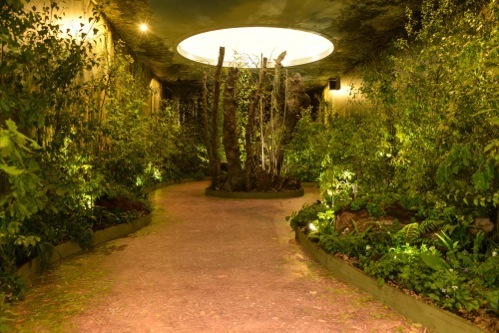Woodland Trust Wins Silver At RHS Chelsea
Description
The Woodland Trust’s RHS Chelsea exhibit ‘Beauty Sleeping’ which highlights the need to protect and restore the nation’s irreplaceable ancient woodland has been awarded a silver medal.
The exhibit was conceptualised and built by the Woodland Trust and Vidar’s Simon Hill (Janvs), with the planting scheme designed by Liz Davies of Catalpa, takes visitors on a journey from a dark conifer plantation through to beautiful ancient woodland in the centre, cascaded in dappled light.
The exhibit illustrates the wealth of native plants, trees and biodiversity associated with ancient woodland and highlights the impact and importance of restoration of ancient woodland sites. The plants used to create the exhibit are inspiration for gardeners who want to encourage wildlife and biodiversity in their gardens.
The exhibit is a truly multi-sensual experience: visitors will experience the sights, sounds and smells of ancient woodland as they walk through it, illustrating the biodiversity, wildlife and aesthetic benefits of restoring ancient woodland and related horticultural aspects.
Ancient woodland is scarce and irreplaceable. It supports our rarest and most vulnerable species – The Trust aims to show why this matters, including interpretation focusing on rich and characteristic woodland flora, complex soils, old trees and deadwood, all hugely valuable for the species that live on them alive with fungi, insects, microbes, worms, lichens, and mosses to bats and insects.
Beccy Speight, Woodland Trust Chief Executive, said: “Ancient woodland is the richest land habitat for species in the UK, having been wooded since at least 1600. It is the natural world’s equivalent of a grade 1 listed building and can’t be recreated simply by planting new trees, but can be restored.
“Many ancient woods were planted with non-native conifers between the 1930s and 1980s to supply much needed timber for industry, resulting in the destruction of hundreds of thousands of hectares of ancient woodland.
“The best way to restore these woods back to their former glory is to change the woodland canopy structure gradually, slowly removing the conifers to let the light back in. Restoration is the only way to protect the long-term future of the last 2% of ancient woodland that remains in the UK.
"The UK is one of the least wooded parts of Europe with 13% woodland cover, only 2% is ancient woodland (around 450,000 hectares). Of this ancient woodland just over half survives naturally, the rest has been felled and planted with exotic conifers or damaged by invasive species like rhododendron.”
Ancient woodland restoration must be done sensitively and can take a long time. Successful restoration relies on maintaining the right light levels to encourage the rejuvenation and spread of ancient woodland flora and the prevention of the domination of course vegetation.
These degraded ancient woodlands still retain many of the components of ancient woodland communities, including hidden biodiversity within deadwood and undisturbed forest soils. 42 species can directly benefit from restoration, including bluebell, wood sorrel and early purple orchid.
Although habitats may have been damaged by plantations, they have not been destroyed. However, the longer action is delayed, the less likely it is to succeed. This is a time-limited opportunity because many of these planted ancient woodlands (PAWS) are increasingly due to be felled again and could be replanted with a further crop of conifers, compounding the damage done to wildlife that remains.
There are 228,000 hectares of planted ancient woodland sites across the UK.
The Woodland Trust has received £1.9m from the Heritage Lottery Fund (HLF) for a UK-wide project which could see the restoration of 52,000 hectares (200 square miles) of damaged ancient woodland.
The five year project, active on the ground in 2014, could see the restoration of an area of woodland one third the size of London across 10 priority areas throughout the country; from the Glens of Scotland to Exmoor. The Trust plans to work with over 1,000 landowners, offering information, advice and training to help them restore conifer woods to their natural broadleaved state.



